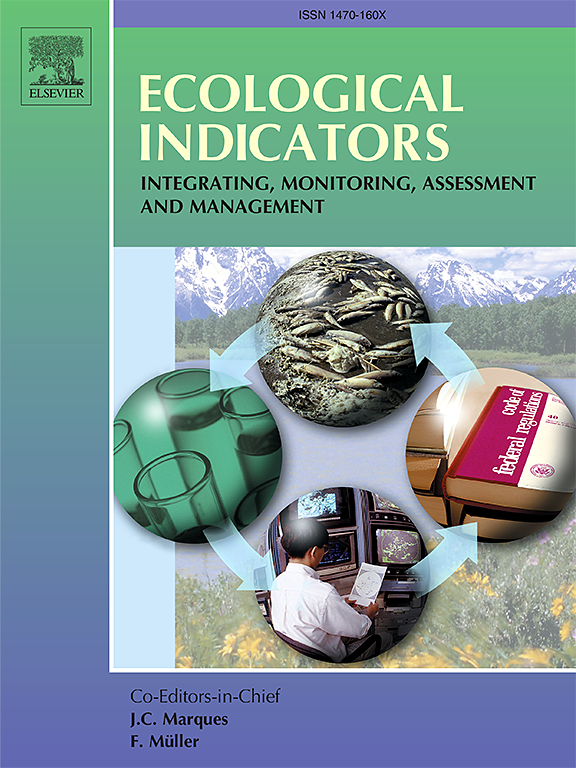How do exergy-based indicators respond to physical habitat changes?
IF 7
2区 环境科学与生态学
Q1 ENVIRONMENTAL SCIENCES
引用次数: 0
Abstract
Eco-exergy and specific eco-exergy are thermodynamic indicators widely used in recent decades to monitor the ecological status of aquatic ecosystems. However, there is still a gap in the knowledge of how these indicators respond to variations in stream physical habitat resulting from natural variation or anthropogenic disturbances. Our objective was to determine what instream physical habitat metrics are related to the variation of eco-exergy and specific eco-exergy from benthic macroinvertebrates and fish assemblages in southeastern Brazil. For benthic macroinvertebrate assemblages, eco-exergy positively correlated with Catchment Disturbance Index scores, whereas specific eco-exergy was positively correlated with Mean Depth. For fish assemblages, eco-exergy was positively correlated with Mean Dead Wood Fish Cover. In contrast, specific eco-exergy was positively correlated with Local Disturbance Index scores and was negatively associated with Mean Depth, Mean Percentage of Riffle, and Mean Undergrowth Proportion. Our results show that exergy-based indicators respond well to natural and human changes in various aspects of instream physical habitat. Whereas their capacity to respond directly to anthropogenic disturbances differ by the assemblage used to calculate eco-exergy and specific eco-exergy, both indices may be useful tools for environmental managers and decision-makers to respond to multiple aspects of lotic ecosystem physical habitat conditions.
基于能量的指标如何应对物理生境变化?
生态能(Eco-exergy)和比生态能(specific Eco-exergy)是近几十年来广泛用于监测水生生态系统生态状况的热力学指标。然而,关于这些指标如何响应自然变化或人为干扰造成的河流物理栖息地变化的知识仍然存在空白。我们的目标是确定巴西东南部底栖大型无脊椎动物和鱼类群落的生态能和特定生态能变化与河流物理栖息地指标的关系。对于底栖大型无脊椎动物群落,生态能与集水区扰动指数得分呈正相关,而特定生态能与平均深度呈正相关。鱼类群落的生态能与平均枯木鱼盖度呈显著正相关。与此相反,特定生态能与局部干扰指数得分呈正相关,与平均深度、平均皱纹百分比和平均林下植被比例呈负相关。研究结果表明,基于用能的指标对河流自然生境的自然和人为变化有较好的响应。尽管它们对人为干扰的直接响应能力因用于计算生态能和具体生态能的组合而异,但这两个指标都可能是环境管理者和决策者对生态系统物理栖息地条件的多个方面作出响应的有用工具。
本文章由计算机程序翻译,如有差异,请以英文原文为准。
求助全文
约1分钟内获得全文
求助全文
来源期刊

Ecological Indicators
环境科学-环境科学
CiteScore
11.80
自引率
8.70%
发文量
1163
审稿时长
78 days
期刊介绍:
The ultimate aim of Ecological Indicators is to integrate the monitoring and assessment of ecological and environmental indicators with management practices. The journal provides a forum for the discussion of the applied scientific development and review of traditional indicator approaches as well as for theoretical, modelling and quantitative applications such as index development. Research into the following areas will be published.
• All aspects of ecological and environmental indicators and indices.
• New indicators, and new approaches and methods for indicator development, testing and use.
• Development and modelling of indices, e.g. application of indicator suites across multiple scales and resources.
• Analysis and research of resource, system- and scale-specific indicators.
• Methods for integration of social and other valuation metrics for the production of scientifically rigorous and politically-relevant assessments using indicator-based monitoring and assessment programs.
• How research indicators can be transformed into direct application for management purposes.
• Broader assessment objectives and methods, e.g. biodiversity, biological integrity, and sustainability, through the use of indicators.
• Resource-specific indicators such as landscape, agroecosystems, forests, wetlands, etc.
 求助内容:
求助内容: 应助结果提醒方式:
应助结果提醒方式:


